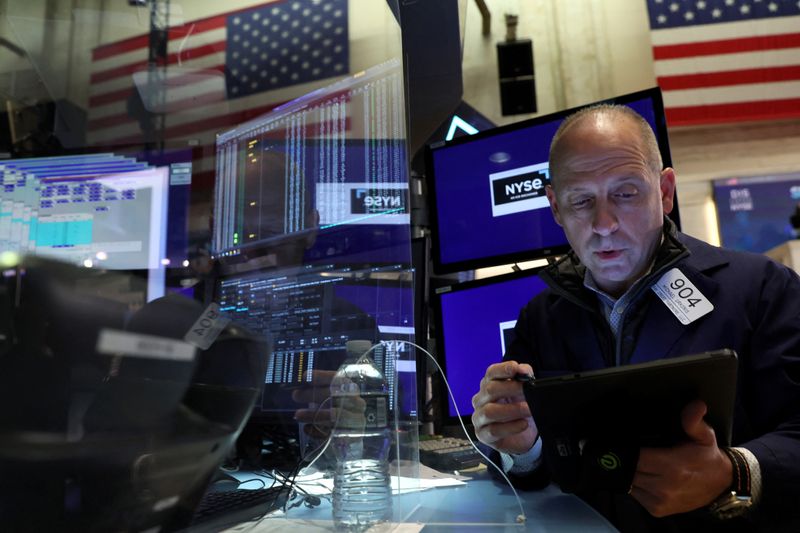Investing.com -- U.S. stock futures point lower, with investors keeping an eye on corporate results and an upcoming string of key economic data releases next week. Shares in chip designer Arm Holdings (NASDAQ:ARM) slip in extended hours trading after it unveiled a weaker-than-anticipated full-year revenue outlook despite a spike in enthusiasm around artificial intelligence. Meanwhile, trading platform operator Robinhood (NASDAQ:HOOD)'s quarterly returns top estimates, sending shares higher after the close of U.S. trading on Wednesday.
1. Futures lower
U.S. stock futures edged lower on Thursday following a mixed performance in the prior session, as investors digested a series of fresh corporate earnings and continued to assess the path ahead for Federal Reserve monetary policy.
By 03:30 ET (07:30 GMT), the Dow futures contract had shed 43 points or 0.1%, S&P 500 futures had slipped by 8 points or 0.2%, and Nasdaq 100 futures had inched down by 36 points or 0.2%.
The 30-stock Dow Jones Industrial Average rose to its sixth consecutive positive session on Wednesday, but it was a tepid day for the other major averages on Wall Street. The benchmark S&P 500 ended the day unchanged, while the tech-heavy Nasdaq Composite dipped by 0.2%.
Shares in megacap groups like Amazon (NASDAQ:AMZN) and Nvidia (NASDAQ:NVDA) in particular were dented by an uptick in 10-year Treasury yields, in a potential indication of tempering hopes that the Fed may roll out interest rate cuts sooner than previously expected later this year.
Outside of quarterly earnings reports from individual companies (more below), analysts were looking ahead to a series of key economic indicators next week, including the release of consumer price data -- a closely-watched gauge of inflation -- on May 15.
2. Arm full-year revenue forecast falls shy of estimates
Shares in Arm Holdings dipped in extended hours trading after the chip designer delivered annual revenue guidance that fell short of estimates despite a wave of enterprise spending on artificial intelligence.
For its 2024 fiscal year, the SoftBank-backed company forecast revenue of between $3.8 billion and $4.1B, or $3.95B at the midpoint, just shy of expectations for $4.01B.
But the firm, which licenses chip designs to manufacturers who then pay them royalties for each semiconductor unit shipped, reported fiscal fourth-quarter adjusted earnings per share (EPS) of $0.36 on revenue of $928 million. That was ahead of Wall Street projections for EPS of $0.21 and sales of $780.2M.
License revenue rose 60% versus a year ago to $414M, driven by "multiple high-value license agreements being signed as companies increase investment in Arm-based technology for AI across all end markets," the group said.
It marked the third earnings report since Arm went public in one of the most highly-anticipated U.S. listings in nearly two years. Arm's stock price has surged since the IPO, leaving it with a market capitalization of $109.06B ahead of the earnings release.
3. Robinhood beats quarterly estimates, sending shares higher
Robinhood shares jumped following the market close on Wednesday after the company’s first-quarter earnings and revenue topped analyst expectations.
The trading platform operator posted earnings per share of $0.18 in the three-month period, surpassing consensus estimates of $0.05. Net revenues came in at $618 million, exceeding projections of $543.14 million.
Adjusted core income rose 115% year-over-year to $247 million, boosted by strong crypto trading volumes and an elevated borrowing cost environment that lifted net interest revenue.
“We continued to aggressively execute on our product roadmap," said Vlad Tenev, CEO and co-founder of Robinhood.
Reacting to the results, analysts at Mizuho said they "could not have asked for a better [first quarter]."
4. Chinese exports and imports return to growth
China's exports increased by more than anticipated in dollar terms in April, possibly signalling momentum in the country's key manufacturing sector that Beijing hopes could support a broader economic recovery.
The value of exports rose 1.5% year-on-year last month, compared to expectations for an uptick of 1%. The figure had tumbled 7.5% in March, a contraction that economists suggested may have been linked to a move by Chinese exporters to lower prices in order to boost sales.
Meanwhile, the value of imports surged 8.4% in April, blowing past expectations for a rise of 5.4% and also recovering from a 1.9% drop in March. The outsized print was in part driven by a weaker base for comparison from the prior year, but also indicated some recovery in domestic demand.
5. Chinese trade data bolsters oil prices
Crude prices rose Thursday, boosted by falling U.S. crude inventories as well as upbeat trade data from China, the largest importer of oil in the world.
By 03:30 ET, the U.S. crude futures traded 0.6% higher at $79.47 per barrel, while the Brent contract climbed 0.5% to $84.02 per barrel.
U.S. crude inventories dropped last week by 1.4 million barrels, according to data from the Energy Information Administration - something of a surprise after the industry body American Petroleum Institute indicated earlier this week that inventories grew 0.5 million barrels.
Adding to the positive tone was the news that shipments of crude to China, the world’s second-largest economy, in April, were 44.72 million metric tons, or about 10.88 million barrels per day, according to data released earlier Thursday. That represented a 5.45% increase from the relatively low 10.4 million bpd imported in April 2023.
